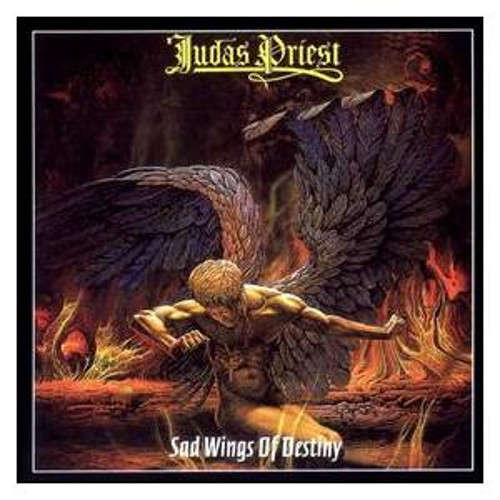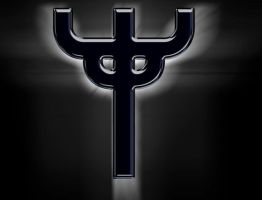
The reason why Judas Priest’s “Sad Wings of Destiny” is the second on the roll is also very practical as Accept’s: it was already written.
Well, let’s keep on going with the series of breakthrough albums with one that maybe is the album that defined Metal as a musical genre: Judas Priest’s “Sad Wings of Destiny.” There has been a harsh discussion about it for a long time. Some people defend the idea that Judas Priest’s “Sad Wings of Destiny” is the first metal album. Well, to make my point, I do not agree with that. In some points, those who defend this idea are correct. Musically speaking, Judas Priest’s “Sad Wings of Destiny” is much more near modern metal than Black Sabbath’s Black Sabbath – the other breakthrough album we are going to cover. But Metal is not only the musical aspect – this is a very point important to mention. It is also attitude. It is impossible to deny the force, power, heaviness, and gloomy atmosphere of Black Sabbath. But fear not, the star today is Judas Priest’s “Sad Wings of Destiny.”
I have something to say before starting to write about this particular album. I must confess that Judas Priest is one of the bands I like most. Not only that I like their songs and things, but it was their music that made me pass through my teens almost unharmed (Well, I said almost!). It is a band I respect and brings me good memories besides their pioneering. But not this particular album. Funny, hum? I will explain later on this text. I respect it for what it meant for The Priest. My favorite albums are a tie among “British Steel,” “Screaming for Vengeance” and “Painkiller.” Tough task choosing one of those. I really do not remember exactly when I ran into the album for the first time. Due to the issues in breaking the contract with Gull Records, “Sad Wings of Destiny” was not an easy album to find. If memory serves me correctly, the first time I was in touch with its songs was when I heard “Unleashed In The East.” Yeah, guys. That happens even to the most loyal Judas Priest and Metal fan.
And The Priest is metal! Metal is the kind of music that me pass through my teens and made me being of I am and feeling part of a bigger thing. My metal buddies sure know what I am saying. And The Priest was the band that made Metal, Metal! If Sabbath invented it, The Priest was who that made it real Metal! And it was “Sad Wings of Destiny” that made Judas Priest “The Priest.”
The first wave of Metal was in a kind of blur. “Deep Purple,” “Led Zeppelin,” “Uriah Heep”sure are nice bands, but they were still kind of heavy rock if you know what I am saying. Man, I love these bands, but later some of them were ashamed or refused to be called Heavy Metal. Not the Sabbath, of course! But even Tony Iommi had his times of distrust, of not knowing if he liked it or not. He said that in an interview I saw some time ago (Don’t ask me where and when!). If asked, some were unanimous to mention that Judas Priest were Metal, not them.
But not The Priest! Judas Priest have always been identified with Metal! And no questions about it!
The musical breakthrough
Its first track, “Victim of Changes,” brings it on. Pay attention to the leading guitar phrase. It is not played on a pentatonic, it is a major scale. There is also the pizzicato throughout it, a technique that brings more heaviness to riffing. Not to mention Mr. Halford’s pitches. The thing is, in “Sad Wings of Destiny,” the guitar phrasing is not bluesy anymore as in Led Zeppelin, or even Black Sabbath. It is more straight ahead, direct. Thanks to the most famous guitar duo in Metal: K. K. Downing and Glen Tipton.
It was The Priest that wiped away all that bluesy influence and brought classical structures. I love bands that use blues as an influence but they sound protometal. Cactus is a nice example. Sure not The Priest! And I am not talking about the Sabbath again, right? Black Sabbath is Black Sabbath and period!
Maybe because of the vocal range of Mr. Halford, the guy is a natural born tenor without the academical study, it would be impossible to apply the blues structure that was commonly used in rock and heavy rock back then. There had to be another melodic way. Music in “Sad Wings of Destiny” is ordered to be played with classical music structures. Note that Judas Priest wiped off the rock’n’roll riffing too so present in bands like early Kiss, Nazareth, and others. Most moments it is only the pure powerchord, which gives more strength to the music. Musically speaking Judas Priest’s musical structures are clean, straight ahead powerchords. And lots of major scale guitar phrasing in riffing.
When playing, the guitar duo gives more attention to the sound effects of the chords. The overdrive effect provides more length to notes. Tipton and Downing noted that perfectly. Also, the duo perceived that the emphasis provided by the drive makes a single note do a lot of fuzz. You do not need to play lots of notes to be heavy, it is the opposite. Moreover, Judas Priest are a riff-driven band.
“Sad Wings of Destiny” is a cohesive album. One may feel the leading idea passing through it. It is much different from its predecessor “Rocka Rolla” that was a hodgepodge of styles and textures.
In this album Mr. Halford showed everything he has got. High pitched notes with aggressive singing. A rare tuning and such a beautiful voice! An unforgettable male tone even with the ability of getting so high pitches!
How about the guitar work?
Well, it was the duo that created duos in Metal! Only that!
Creative riffs, sharp licks, undisguisable tones!
Glenn Tipton and K. K. Downing created a single style which was copied by every duo of guitar players in the music world.
Many people forget Ian Hill and his bass playing. But it fits so naturally to the sings that it is a shame to get him aside. Musicians know well that it is more difficult to create something simple that fits well then to create some ridiculously difficult line that do not fit well only to be a show off and Hill is not a show off. He stays in the back of the stage doing his Hill playing with his heads giving the music the impact of the tones and leaving the guitars free to fly. He may not be the best but we ought to respect the man!
Later on, The Priest would abandon the slow tempo songs and the piano in order to be the fastest and heaviest band ever. It was such a pity! Slower tunes came back during “Angel of Retribution” which was kind of late sequence of “Sad Wings.” And the band liked it so much that the following albums had the same touch.
Take a look at the track listing (LP, of course!):
Side 1
1. Victim of Changes
2. The Reaper
3. Dreamer Receiver
4. Deceiver
Side 2
1. Prelude
2. Tyrant
3. Genocide
4. Epitaph
5. Island of Domination
Instant classics and that’s all!
Attitude
It was The Priest who had the guts to go on stage with a Harley Davidson and spank it with a whip. And it was The Priest who had again the guts to be go on stage dressed with black leather and spikes. This is also a huge controversy. Some say the look was taken from bikers; others that it was taken from the sadomasoquist, and others from the gay community. Which one is right? We really do not know.
As I said before, Judas Priest were the band that early embraced, and lived, the term Heavy Metal. As the finances were tight because Gull Records provided a recording budget of £1,000 for “Sad Wings of Destiny,” the band had to take only one meal a day, and several took on part-time work: Tipton as a gardener, Downing in a factory, and Hill driving a delivery van. The intent was to make “Sad Wings of Destiny” a straight-ahead rock with a progressive edge. And they got much more than that.
“Sad Wings of Destiny” was originally released in 1976 and was obscured by the upcoming of punk rock so its sales were never compatible to its importance. Many metal musicians list it as the essential play to theirs choices of playing metal. The grandiosity of its guitar playing and the magnificence of Mr. Halford’s vocals were too much for the punk movement.
It is the first to show the “Priest cross” in its cover. It would only make its comeback with “Painkiller” and then in all albums as a symbol of the band.

The enigmatic cover art
Even though in 1976 people were a bit more used to Heavy Metal iconography, dark and enigmatic cover arts like the one in “Sad Wings of Destiny” were not that common. It was David Howells of Gull records who commissioned Patrick Woodroffe to provide the cover art. It is called Fallen Angel and depicts a struggling, grounded angel surrounded by flames and wearing a devil’s three-pronged cross, which was the band’s symbol. Halford posed Christ-like on the reverse, and Gothic fonts adorned the front and back. The same idea would be replicated in “Painkiller” and in “Angel of Retribution,” which main theme circles around a fallen angel.
To be done with that I must say that every metal band all around the world should before the shows do a loud “Hail The Priest!” to pay the due respect to the band.
I’m just a lucky guy who has chosen metal to live with for a long time. Metal changed my life for good. It made me more confident and stronger. Metalheads are naturally far away from the mass mediocrity and don’t accept impostures from anybody else. Metal is more than music, it’s a life changing oportunity!